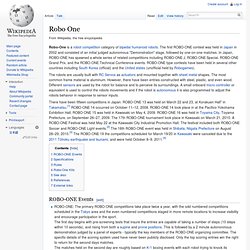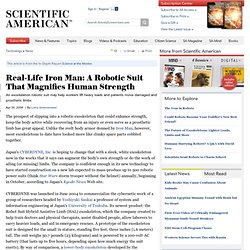

Robo One. Robo-One is a robot competition category of bipedal humanoid robots.

The first ROBO-ONE contest was held in Japan in 2002 and consisted of an initial judged autonomous "Demonstration" stage, followed by one-on-one matches. In Japan, ROBO-ONE has spawned a whole series of related competitions including ROBO-ONE J, ROBO-ONE Special, ROBO-ONE Grand Prix, and the ROBO-ONE Technical Conference events. ROBO-ONE type contests have been held in several other countries including South Korea (official) and the United states (unofficial held by Robogames). The robots are usually built with RC Servos as actuators and mounted together with sheet metal shapes. The most common frame material is aluminum. There have been fifteen competitions in Japan.
ROBO-ONE Events[edit] Specifications[edit] Early ROBO-ONE specifications were deliberately minimal to encourage as much participation as possible. With ROBO-ONE 11 (March 2007), the concept of weight classifications was introduced. Rules[edit] See also[edit] Real-Life Iron Man: A Robotic Suit That Magnifies Human Strength. The prospect of slipping into a robotic exoskeleton that could enhance strength, keep the body active while recovering from an injury or even serve as a prosthetic limb has great appeal.

Unlike the svelt body armor donned by Iron Man, however, most exoskeletons to date have looked more like clunky spare parts cobbled together. Japan's CYBERDYNE, Inc. is hoping to change that with a sleek, white exoskeleton now in the works that it says can augment the body's own strength or do the work of ailing (or missing) limbs. The company is confident enough in its new technology to have started construction on a new lab expected to mass-produce up to 500 robotic power suits (think Star Wars storm trooper without the helmet) annually, beginning in October, according to Japan's Kyodo News Web site.
The HAL exoskeleton is currently only available in Japan, but the company says it has plans to eventually offer it in the European Union as well. Exoskeletons Are on the March. 17 August 2009—An army of exoskeletons is coming.

And according to their inventor, Professor Yoshiyuki Sankai of the University of Tsukuba, in Japan, they’re making a difference in the lives of disabled people. Speaking at the International Conference on Intelligent Robotic Technology and Business, held earlier this month in Taipei, Taiwan, Sankai proudly described how the robotic exoskeleton suit HAL (short for Hybrid Assistive Limb), helped a 46-year-old man whose left leg was withered by polio when he was 11 months old.
HAL reads electric signals at the surface of the skin that are generated by the muscle beneath and then uses them to guide the movement of robotic limbs strapped to a person’s real limbs, thereby multiplying their strength. The polio patient’s withered left leg generated extremely weak bioelectric signals at first, and the robotic limb remained unmoved.
Ten days later, with HAL’s assistance, the patient moved his left leg based on his own intention. Troy Hurtubise. Troy James Hurtubise (born November 23, 1963) is an inventor and conservationist from North Bay, Ontario, Canada noted for his often bizarre creations that he tests on himself in spectacular ways.

Some of these inventions include the Ursus personal armor suit, firepaste (an ablative heatproofing material), various ray generators, and recently, Trojan, which is a type of body armor. He was born in Hamilton, Ontario.[1] Firepaste[edit] 1313 Paste[edit] It is Hurtubise's desire to see military vehicles, currently in service in Afghanistan, equipped with such protection in order to stand up to a landmine explosion, which has already claimed the lives of Canadian soldiers serving there. Angel Light[edit] According to Hurtubise, the device makes walls, hands, stealth shielding, and other objects transparent. Trojan armour[edit] In early 2007, Hurtubise made public his new protective suit which was designed to be worn by soldiers. Project Grizzly - Testing the different iterations of the suit. Poweriser Extrem. Raytheon unveils lighter, faster, stronger second generation exoskeleton robotic suit.
TEWSKBURY, Mass., (Sept. 27, 2010) /PRNewswire/ — Raytheon Company (NYSE: RTN) unveiled its second generation Exoskeleton (XOS 2) at its research facility in Salt Lake City, Utah, during a demonstration with Paramount Home Entertainment.

The new robotic suit is lighter, faster and stronger than its predecessor, yet it uses 50 percent less power. Its enhanced design also means that it is more resistant to the environment. “XOS 1 was essentially a proof of concept,” said Dr. Fraser M. Smith, vice president of operations for Raytheon Sarcos. Raytheon is developing the robotic suit to help with the many logistics challenges faced by the military both in and out of theater. The suit is built from a combination of structures, sensors, actuators and controllers, and it is powered by high pressure hydraulics.
“Getting exoskeletons deployed is inevitable in my view,” said Smith. Note to Editors: The impact protection company.